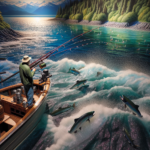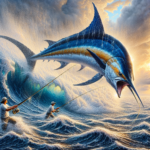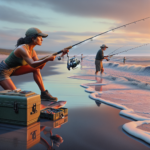Deep-Sea Fishing for Swordfish in Florida’s Atlantic Coast

Introduction
Imagine the thrill of battling a powerful swordfish, its long, flat bill slicing through the water as it fights to free itself from your line. Deep-sea fishing for swordfish off Florida’s Atlantic Coast offers this exhilarating experience and more. This article will delve into the techniques, species information, top fishing spots, and essential gear for swordfish fishing in this region. Whether you’re a seasoned angler or a novice, understanding the intricacies of swordfish fishing can enhance your experience and increase your chances of a successful catch.
Why does this matter? Swordfish are not only a prized catch for their size and strength but also for their culinary value. Knowing where and how to fish for them can make your fishing trips more productive and enjoyable. Additionally, understanding the regulations and best practices ensures that you contribute to the sustainability of this magnificent species.
Background/Context
Historical or Cultural Significance
Swordfish have been a part of human culture for centuries, revered for their size, strength, and culinary value. Historically, they were hunted by various coastal communities for food and trade. In Florida, swordfish fishing has evolved from a subsistence activity to a popular sport, attracting anglers from around the world.
Geographical Overview
Florida’s Atlantic Coast, stretching from the Georgia border to the Florida Keys, offers diverse fishing environments. The Gulf Stream, a warm ocean current, flows close to the coast, creating ideal conditions for swordfish. The region’s climate is generally warm and humid, with mild winters and hot summers, making it a year-round fishing destination.
Key Points/Details
Fishing Techniques
Technique Overview
Deep-sea fishing for swordfish typically involves two main techniques: daytime deep-dropping and nighttime drift fishing. Daytime deep-dropping uses heavy tackle and electric reels to drop baits to depths of 1,200 to 1,800 feet. Nighttime drift fishing, on the other hand, involves drifting baits at various depths, usually between 100 and 400 feet, as swordfish come closer to the surface to feed.
When and Where to Use
Daytime deep-dropping is best during the summer months when swordfish are more active in deeper waters. Nighttime drift fishing can be effective year-round but is particularly productive during the fall and winter months. Prime locations include the waters off Miami, Fort Lauderdale, and the Florida Keys, where the Gulf Stream brings nutrient-rich waters close to shore.
Recommended Gear
- Rods: Heavy-duty rods capable of handling 50- to 80-pound lines.
- Reels: Electric reels for daytime deep-dropping and conventional reels for nighttime drift fishing.
- Lines: Braided lines with a high breaking strength (80- to 200-pound test).
- Bait: Squid, mackerel, and bonito are popular choices.
- Terminal Tackle: Circle hooks, heavy sinkers, and light sticks for nighttime fishing.
Species Information
Species Overview
Swordfish (Xiphias gladius) are large, predatory fish known for their elongated, flat bills. They are highly migratory and can be found in both temperate and tropical waters. Swordfish are solitary hunters, feeding on a variety of fish and squid. They are known for their powerful, acrobatic fights when hooked, making them a challenging and rewarding catch.
Best Practices
To successfully catch swordfish, use fresh bait and ensure it is properly rigged. Pay attention to water temperature and currents, as swordfish are more likely to be found in areas with favorable conditions. Patience is key; swordfish can be elusive, and it may take time to locate and hook one. Always follow local regulations and practice catch-and-release when possible to help conserve the species.
Location Information
Top Fishing Spots
- Miami: Known for its proximity to the Gulf Stream, Miami offers excellent swordfish fishing opportunities.
- Fort Lauderdale: Another prime location with easy access to deep waters.
- Florida Keys: The waters around the Keys are rich in marine life, making it a top destination for swordfish anglers.
Regulations and Licenses
Florida requires a saltwater fishing license for all anglers. Specific regulations for swordfish include size limits (minimum 47 inches lower jaw fork length) and bag limits (one per person per day, with a maximum of four per vessel). Always check the latest regulations from the Florida Fish and Wildlife Conservation Commission (FWC) before heading out.
Seasonal Considerations
Seasonal Variations
Fishing conditions can vary significantly throughout the year. Summer months are ideal for daytime deep-dropping, while fall and winter are better for nighttime drift fishing. Weather conditions, such as hurricanes and tropical storms, can also impact fishing, so always check the forecast before planning your trip.
Best Times to Fish
The best times to fish for swordfish are during the new moon and full moon phases, when tidal movements are stronger, and swordfish are more active. Early morning and late evening are also productive times, especially for nighttime drift fishing.
Events and Tournaments
Event Overview
Florida hosts several swordfish tournaments throughout the year, attracting anglers from across the globe. Notable events include the Miami Swordfish Tournament and the Key West Swordfish Challenge. These tournaments offer cash prizes, trophies, and the opportunity to compete against some of the best anglers in the sport.
Preparation Tips
To prepare for a tournament, ensure your gear is in top condition and practice your techniques. Study the tournament rules and regulations, and plan your strategy based on the expected conditions. Pre-fishing the tournament area can also give you an advantage by helping you locate productive spots.
Tips and Best Practices
General Tips
- Use fresh bait and change it regularly to keep it attractive to swordfish.
- Pay attention to water temperature and currents, as these can influence swordfish behavior.
- Be patient and persistent; swordfish can be elusive, and it may take time to locate and hook one.
Avoid Common Mistakes
- Using old or poorly rigged bait can reduce your chances of a successful catch.
- Ignoring weather conditions can lead to dangerous situations; always check the forecast before heading out.
- Failing to follow local regulations can result in fines and harm the swordfish population.
Advanced Techniques
- Experiment with different bait presentations and depths to find what works best in your area.
- Use a fish finder to locate swordfish and adjust your techniques based on their behavior.
- Consider using a kite to present baits at the surface, which can be effective for attracting swordfish.
Gear and Equipment Recommendations
Essential Gear
- Heavy-duty rods and reels capable of handling 50- to 80-pound lines.
- Braided lines with a high breaking strength (80- to 200-pound test).
- Fresh bait such as squid, mackerel, and bonito.
- Circle hooks, heavy sinkers, and light sticks for nighttime fishing.
Optional Gear/Upgrades
- Electric reels for daytime deep-dropping.
- Kite fishing gear for surface presentations.
- Fish finders and other electronic equipment to locate swordfish.
Where to Buy or Rent
Local tackle shops in Miami, Fort Lauderdale, and the Florida Keys offer a wide range of gear and equipment for swordfish fishing. Online retailers such as Bass Pro Shops and TackleDirect also provide a variety of options. Some charter services may offer gear rental as part of their packages.
Safety and Conservation
Safety Tips
- Always check the weather forecast before heading out and be prepared for changing conditions.
- Wear a life jacket and ensure all safety equipment on your boat is in good working order.
- Stay hydrated and protect yourself from the sun with sunscreen, hats, and protective clothing.
Conservation Practices
- Practice catch-and-release whenever possible to help conserve swordfish populations.
- Follow local regulations regarding size and bag limits.
- Respect the marine environment by properly disposing of trash and avoiding damage to coral reefs and other habitats.
Planning Your Trip
Accommodations
There are numerous accommodation options near popular fishing spots along Florida’s Atlantic Coast. In Miami, consider staying at the Miami Beach Resort or the Fontainebleau Miami Beach. Fort Lauderdale offers options such as the Hilton Fort Lauderdale Marina and the Bahia Mar Fort Lauderdale Beach. In the Florida Keys, the Cheeca Lodge & Spa and the Hawks Cay Resort are excellent choices.
Travel Tips
Miami International Airport and Fort Lauderdale-Hollywood International Airport are major gateways to the region. Renting a car is recommended for easy access to fishing spots and other attractions. If you’re heading to the Florida Keys, consider driving along the scenic Overseas Highway (U.S. Route 1).
Additional Activities
Florida’s Atlantic Coast offers a variety of activities for non-fishing time. Explore the vibrant nightlife and cultural attractions of Miami, relax on the beautiful beaches of Fort Lauderdale, or enjoy water sports and eco-tours in the Florida Keys. The region also boasts excellent dining options, with fresh seafood being a highlight.
Frequently Asked Questions (FAQs)
What is the best time of year to fish for swordfish in Florida?
The best time for daytime deep-dropping is during the summer months, while nighttime drift fishing is productive year-round, particularly in the fall and winter.
Do I need a special license to fish for swordfish in Florida?
Yes, a saltwater fishing license is required, and specific regulations for swordfish include size limits and bag limits. Always check the latest regulations from the Florida Fish and Wildlife Conservation Commission (FWC).
What gear do I need for swordfish fishing?
Essential gear includes heavy-duty rods and reels, braided lines, fresh bait, circle hooks, heavy sinkers, and light sticks for nighttime fishing. Electric reels and fish finders are useful upgrades.
Are there any local tournaments for swordfish fishing?
Yes, notable tournaments include the Miami Swordfish Tournament and the Key West Swordfish Challenge. These events offer cash prizes, trophies, and the opportunity to compete against top anglers.
Conclusion
Deep-sea fishing for swordfish off Florida’s Atlantic Coast is an exhilarating experience that combines skill, patience, and a bit of luck. By understanding the techniques, species information, top fishing spots, and essential gear, you can enhance your chances of a successful catch. Remember to follow local regulations and practice conservation to ensure the sustainability of this magnificent species. Whether you’re a seasoned angler or a novice, the thrill of battling a powerful swordfish awaits you in the waters off Florida’s Atlantic Coast.




